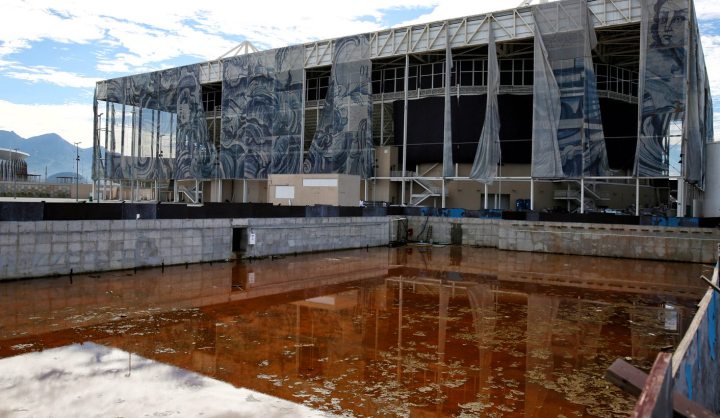Sport
Rio 2016: An Olympics legacy of despair and wreckage

Decaying Olympic stadiums are nothing new. There have been countless photo essays of venues falling into disrepair, but it has taken an unprecedented six months for Rio’s venues to fall apart. As soon as the world averted its gaze, reality’s bony fingers took hold. By ANTOINETTE MULLER.
When any country hosts a major sporting event, the organisers and those politicking behind it will talk about the “legacy” it’ll leave. More often than not, these promises are unfulfilled. Expensive stadiums go to ruin as they stand unused. Sometimes, money is pumped into the maintenance of these facilities without bringing any benefit to the communities in which they were plonked down.
The lead-up to the 2016 Rio Olympics was no different. But just six months after the event and the decay has already begun.
It’s hardly a surprise – the country has been in economic turmoil for some time. Since the Games, the unemployment rate has doubled and the GDP has fallen by 8.4%percent. Rio was broke before the Games even began and things only got worse from there.
During the Games, a federal bailout ensured police could patrol and hospitals could stay open, but it has slipped further and further into economic turbulence since the crowds left and the world averted its gaze. Public employees are not being paid and the government is desperately trying to stay afloat by implementing aggressive austerity measures, which includes slashing state workers’ wages and pensions by 30%. Everything from corruption to the stagnant oil price and tax breaks have made it difficult for both Rio and Brazil to stay afloat.
According to pri.org, an auditor found that Rio missed out on 138-billion reais (about $40-billion) in corporate taxes between 2008 and 2013. It amounts to almost twice the state’s annual budget of about 80-billion reais.

Photo: An aerial view shows the Olympic Aquatics Stadium, which was used for the Rio 2016 Olympic Games, in Rio de Janeiro, Brazil January 15, 2017. Picture taken on January 15, 2017. REUTERS/Nacho Doce
Behind closed doors, nobody really thought hosting the Olympics was a good idea. Most people, though, thought that the local economy might be given a moderate boost and, at the very least, the Games would leave some sort of legacy for the ordinary people whose lives it disrupted.
Rio’s current reality, though, is grimmer. The bastion of these so-called legacy projects was the conversion of the canoe slalom course into a public swimming pool. After closing in December, the city has no idea when that might actually happen. With temperatures in Rio regularly in the mid-30s, the locals would like to know, too. Instead, they say the government has turned its back on them.
But the would-be public pool isn’t the only post-Games failure. Reuters’ photographer Pilar Olivares recently captured images that show the desolation of some of the venues.
The Rio Olympics pool, which was tinged green during the pomp of the event last year, is no longer even a colour. It’s gone. The warm-up pool is no better. It is piled with dirt and infested with mosquitos. The broadcast centres are still only half demolished.
.jpg)
Photo: An aerial view shows the 2016 Rio Olympics golf venue which was used for the Rio 2016 Olympic Games, in Rio de Janeiro, Brazil, January 15, 2017. Picture taken January 15, 2017. REUTERS/Nacho Doce
The Maracanã Stadium, where the Rio Games’ opening and closing ceremonies took place, is in shambles. The field has turned brown and electricity to it was recently cut with a reported $1-million owed to the electricity company. There is a dispute over the state in which the stadium was returned to those who manage it. The units in the Athletes’ Village, which were supposed to become luxury flats, remain unsold.
Pictures like these aren’t exactly new. There have been countless photo essays documenting the ruins of past Olympic venues. It is not unusual for Olympic venues that are no longer needed to slip into disrepair – or be demolished to build something else, like Atlanta’s stadium being turned into a car park.

Photo: An aerial view of Maracana Stadium, which was used for the Opening and Closing ceremonies of the Rio 2016 Olympic Games, shows the turf being dry, worn and filled with ruts and holes, in Rio de Janeiro, Brazil January 12, 2017. Picture taken on January 12, 2017. REUTERS/Nacho Doce
But it’s been just six months since Rio’s glitzy event. The decay has been so rapid that if you had not seen the pomp for yourself, you would not believe it if somebody told you the city hosted the Olympics only last year.
A year before Rio 2016 kicked off, a top official in the mayor’s office, Pedro Paulo, promised: “We will leave no white elephants.” Before the closing ceremony, then mayor Eduardo Paes said the same. So far, all of that has been proven false.
The favela which was torn apart to make way for a bus rapid transport (BRT) system has still not recovered. The community plaza and a number of homes were removed by construction in the lead-up to the Olympics and authorities will point to the public transport system as a legacy “win”. But the community say they never got the bus terminal or the new leisure space they were promised.
The new metro also remains too expensive for most members from these communities. The combination of these transport systems was projected to service 300,000 passengers a day. It is only serving 80,000. The temporary stadiums were supposed to be repurposed as schools but that has not happened either.
The list of legacy failings goes on and Rio’s story serves as another cautionary tale of why countries should be wary of even bothering to hosting these events.
But it also raises a pertinent question on what role the International Olympic Committee (IOC) has when it comes to facilitating not just the hosting of these mega-events, but the implementation of legacy projects that are intended to result from them.
The 2016 Olympics was dubbed the “richest” Games ever with TV companies forking out billions for the privilege of broadcasting the event and sponsors lining up to pour even more money into the IOC’s coffers.
As with the Soccer World Cup, it is the governing bodies that are the biggest benefactors and there is no safety clause in place should it all go to pot for the host city. A big problem is that bids for events are awarded years in advance. Rio won its bid in 2009. Back then, the economy was far more stable. The year after winning the bid, the economy had recorded a 7.5% growth and inflation was below target. Things went to hell in a handcart soon afterwards.
Cities vying for events are unlikely to learn from Rio’s story, but perhaps the IOC should start considering what it is doing to the cities they are “rewarding” with these events. At the very least, it should consider some sort of insurance clause for when it becomes quite apparent that the pain caused by playing host will last longer than the stadiums. DM
Photo: A view of the Olympic Aquatics Stadium, which was used for the Rio 2016 Olympic Games, is seen in Rio de Janeiro, Brazil February 5, 2017. Picture taken on February 5, 2017. REUTERS/Pilar Olivares


















 Become an Insider
Become an Insider